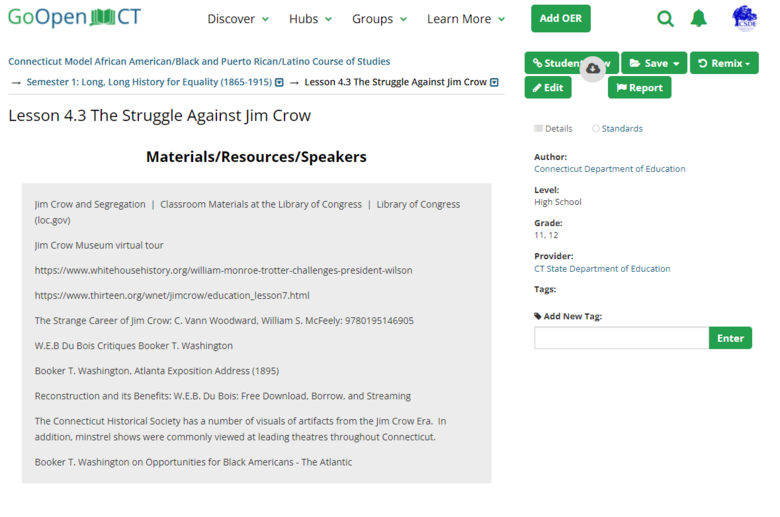Lesson 4.3: The Struggle Against Jim Crow

Overview
Big Ideas/Topics to be Addressed, including Key Concepts and Terms
Jim Crow/Segregation: White Nationalism and Supremacy
Multiple roles of Black Americans in Black empowerment and agency, beyond servitude (e.g., W.E.B. DuBois vs. Booker T. Washington)
Racial violence, and trauma
White Supremacy
Resistance and activism against Jim Crow
Vocabulary: Racial Trauma, Jim Crow, Activism, Lynching, Resistance, Racial Apartheid, Freedom Dreaming
Materials/Resources/Speakers
Jim Crow and Segregation | Classroom Materials at the Library of Congress | Library of Congress (loc.gov)
Jim Crow Museum virtual tour
https://www.whitehousehistory.org/william-monroe-trotter-challenges-president-wilson
https://www.thirteen.org/wnet/jimcrow/education_lesson7.html
The Strange Career of Jim Crow: C. Vann Woodward, William S. McFeely: 9780195146905
W.E.B Du Bois Critiques Booker T. Washington
Booker T. Washington, Atlanta Exposition Address (1895)
Reconstruction and its Benefits: W.E.B. Du Bois: Free Download, Borrow, and Streaming
The Connecticut Historical Society has a number of visuals of artifacts from the Jim Crow Era. In addition, minstrel shows were commonly viewed at leading theatres throughout Connecticut.
Booker T. Washington on Opportunities for Black Americans - The Atlantic
Recommended Learning Activities, including UDL Principles/Scaffolded Supports and Asynchronous and Synchronous Learning Opportunities
Day 1 Jim Crow Laws
Initiation: Revisit Safe Space. Advise students of the sensitive nature of the materials and lesson. Use PROTOCOL Back-to-Back and Face-to-Face
Teacher will ask students to react to laws with a partner. Students respond then rotate to another partner after each question (10 minutes).
All Blacks shall be required to own real property in order to qualify to vote. (New York)
Black children shall be prohibited from attending Pittsburgh schools.
No person or corporation shall require any white female nurse to nurse in wards or rooms in hospitals, either public or private, in which Negro men are placed. (Alabama)
It shall be unlawful for a Negro and white person to play together or in company with each other at any game of pool or billiards. (Alabama)
No colored barber shall serve as a barber [to] white women or girls. (Georgia)
The officer in charge shall not bury, or allow to be buried, any colored persons upon ground set apart or used for the burial of white persons. (Georgia)
After students react to these laws, the teacher will explain that laws such as these existed in the United States and became known as “Jim Crow” laws.
Activity: Analyze photos of Jim Crow era using Analyzing Images Protocol Teaching Strategy: Analyzing Images | Facing History. Example of photos can be found: Jim Crow and Segregation | Classroom Materials at the Library of Congress | Library of Congress (loc.gov) the origins and persistence of the Jim Crow System to 1909
Closing/Evidence of Learning: Students individually write/depict response to prompt: How did Jim Crow influence the life of Blacks?
Day 2 Jim Crow and Racial Trauma
Initiation: Explore the Jim Crow Timeline in groups, stopping at May 31, 1909-June 1, 1909. Share out and discuss actions of the past and today’s society. https://www.ferris.edu/HTMLS/news/jimcrow/timeline/jimcrow.htm
Ida B. Wells-Barnett Consider contributions of Black women in Resistance.
Activity: Ask students to design/create a “Freedom Dream” What is Freedom Dreaming? (message, visual, picture, song) about what changes are needed now to end racial violence and trauma. What will it look and sound like when we get to the Dream or MLK’s mountaintop? Dreams can be created with Apps, paper, or medium of choice.
Form groups of helping trios to give feedback on “Freedom Dreams” from multiple perspectives. Helping Trios
Closing: Using Inside-Outside Circle, students will share reactions/reflections. Prompts: To what extent is the political and social “goodwill” still present to address lingering and current matters of race and equity? What rights should all Americans enjoy? What rights do only some Americans possess?
Day 3 W.E.B. Du Bois and Booker T. Washington (Students will participate in a lesson adapted from Alabama History Education Initiative)
Initiation: Discuss What did the leading Black scholars of the day (W.E.B. Du Bois and Booker T. Washington) believe? What were W.E.B Du Bois’ critiques of Booker T. Washington?
Activity: Access the Booker T. Washington and W.E.B. DuBois: Two Paths to Ending Jim Crow” PowerPoint from W_E_B_DuBois_Booker_T_Washington_and_Jim_Crow_Lesson_October_2010.pdf (alabama.gov). During the PowerPoint, students will use a Compare/Contrast Matrix to draw their own conclusions about the viewpoints of Washington and Du Bois.
Closing: Students individually write/depict response to prompt: As the leading Black scholar of the day, did W.E.B. Du Bois believe Reconstruction was a success or failure?
Home Links/Reflections to Affirm Identity
Reflect on Jim Crow and the residue left today… what actions would you take?
What discoveries are you making about the role of Black women in this period?
Options for Content Continuity Across History Courses and Interdisciplinary Integration
ELA - Students can develop an Exoduster Character that can be developed into a graphic mini novel or comic book story.
Extensions/Experiential Opportunities
Visit local historical societies (in-person/virtual)
The Strange Career of Jim Crow: C. Vann Woodward, William S. McFeely: 9780195146905
Read "Booker T. and W.E.B." by Dudley Randall - Famous poems, famous poets. - All Poetry. “How does the poem illustrate the differences between Washington and DuBois?” Have them add to their Compare/Contrast Matrix
Read/explore in groups: Resistance, activism, the life of William Monroe Trotter https://bit.ly/3vLs4us and Ida B. Wells-Barnett